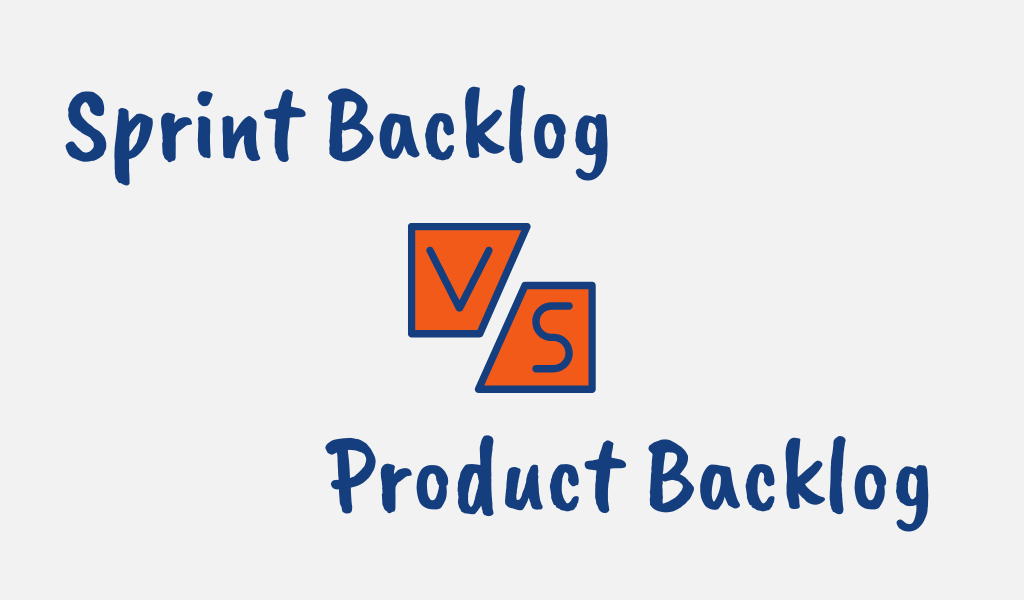Agile frameworks like Scrum have gained immense popularity, especially in recent years for their ability to deliver value quickly and adapt to changing requirements.
Two key components of Agile methodologies are the Product Backlog and Sprint Backlog. While these terms sound similar, they serve different purposes and require unique management.
This article will provide an overview of what each backlog entails, how they are managed and prioritized, and their roles in Sprint Planning and execution.
Whether you’re new to backlogs or want a refresher, this guide will help you leverage the Product Backlog and Sprint Backlog effectively.
Product Backlog in Agile
A Product Backlog is an evolving, prioritized list of work for the development team. It is a crucial artifact for any team using Scrum or other Agile methodologies.
This comprehensive list contains all the features, requirements, and fixes that must be addressed to develop and improve the product.
The Product Backlog serves as the single source of truth for everything that should be built into the product and provides full visibility into all of the team’s work.
It includes
- Product features or user stories describing desired functionality
- Non-functional requirements like security, compliance, or UX
- Bugs, defects, or technical debt to address
- Knowledge acquisition needs or spikes for research

Who Manages the Product Backlog?
The Product Owner (PO) is responsible for managing the Product Backlog and serving as the voice of the customer. The PO makes sure the Product Backlog aligns with the product vision and delivers the maximum business value.
Specific responsibilities include:
- Maintaining the backlog by adding, modifying, and removing work items
- Clearly defining each item and acceptance criteria
- Prioritizing and ordering items based on impact and effort
- Ensuring the backlog is visible, transparent, and understood
What Does the Product Backlog Contain?
While the format can vary, Product Backlog items should have a description, order, estimate, and value.
Product features are written from the user’s perspective as user stories. A user story typically includes:
- A user persona
- What the user wants to achieve
- The expected benefit or value
Backlog items can be grouped into themes to show the big picture. Epics break large initiatives into smaller but still sizable bodies of work.
Refining and Prioritizing the Backlog
To manage the Product Backlog, the Product owner engages in backlog refinement to shape the backlog. Prioritization considers the value, urgency, dependencies, and effort of the Product Backlog items, and the highest priority items rise to the top.
This involves:
- Adding new stories
- Breaking down large items into smaller ones
- Modifying or removing outdated stories
- Re-prioritizing stories based on the latest insights
You can learn Product Backlog prioritization techniques here.
Benefits of Having a Product Backlog
Maintaining an ordered product backlog provides many advantages to the product development process:
- Shows a transparent view of work to be done
- Drives collaboration between product, engineering, and stakeholders
- Enables incremental delivery of value
- Adapts easily to changing needs or feedback
- Provides continuous opportunities to refine priorities
- Sets clear direction while allowing flexibility in implementation

Sprint Backlog in Scrum
The Sprint backlog is a Scrum artifact that represents the work the development team must address within a Sprint to deliver a potentially shippable Product Increment. It consists of:
- User stories pulled from the Product Backlog
- Tasks required to complete each user story
- Bugs, issues, or defects impacting the Sprint Goal
While the Product Backlog provides an overarching view, the Sprint Backlog is a subset that contains granular items to complete during a specific sprint iteration.
The Sprint Backlog is created during Sprint Planning and remains fixed throughout the sprint serving as the plan for executing the Sprint.
Who Owns the Sprint Backlog?
The entire cross-functional Scrum development team collectively owns the Sprint Backlog. While the Scrum Master facilitates planning, the team decides what they can realistically complete during the Sprint.
What Does the Sprint Backlog Contain?
The Sprint Backlog contains:
- User stories representing some desired functionality
- Tasks that break a story down into executable units
- Bugs that must be fixed in the increment
- Other work needed to meet the Sprint Goal
How Sprints Are Planned Using the Backlog
During sprint planning, the team:
- Reviews prioritized items on the Product Backlog
- Selects stories they can complete in the sprint
- Decomposes stories into tasks
- Estimates effort for each story and task
- Commits to delivering the sprint backlog
Past team velocity guides how much work typically gets done in a Sprint. This sets capacity.
Tracking Sprint Progress with Burndown Charts
Burndown charts show the work remaining in a Sprint compared to the time left and provide day-by-day tracking.
It should show a consistent downward slope if the team will complete the backlog on time. If the line trends up, stories are not getting done as expected. The team can then take action to get back on track before the Sprint ends.

Product Backlog vs Sprint Backlog: Key Differences
While both backlogs share similarities, there are important distinctions between the Product Backlog and Sprint Backlog.
1. Purpose
The Product Backlog guides the overall product vision and provides a big-picture view of the desired enhancements to deliver value. Its purpose encompasses:
- Defining features required to meet product goals
- Capturing all ideas and requests for the product
- Facilitating prioritization of highest-value work
- Providing complete visibility into future work
The Sprint Backlog on the other hand outlines executable work to perform in a single Sprint. These items are picked from the Product Backlog and reviewed so that they meet the Definition of Ready with the purpose of:
- Outlining work to be completed within the Sprint
- Allowing the team to meet the Sprint Goal
- Creating a tactical plan to build an increment
- Enabling focus on current top priorities
2. Contents
While both backlogs contain user stories, they deal with different levels of detail. The Product Backlog work items include high-level product features and user stories, and larger epics and themes.
The Sprint Backlog work items include detailed user stories small enough to complete during the Sprint, granular developer tasks to implement each story, and bugs scheduled for the increment.
3. Duration Covered
The time span for each backlog varies significantly. The Product Backlog evolves continuously and is ongoing for the product lifecycle.
The Sprint Backlog is fixed for one Sprint duration and is determined Sprint by Sprint.
4. Estimation and Prioritization
Product Backlogs use high-level estimates like story points, and for prioritization consider factors like business value, time sensitivity, dependencies, and effort involved. Its prioritization is more fluid based on changing needs
Sprint Backlog tasks are estimated in hours and are prioritized in alignment with meeting the Sprint Goal.
5. Refinement Processes
Product Backlog refinement happens continuously by adding details to stories over time, splitting large stories into smaller ones, and the team providing input into acceptance criteria
The Sprint backlog takes the user stories as defined for that Sprint, and refinement is represented by decomposition into tasks.
6. Ownership
The Product Backlog is owned and maintained by the Product Owner, who is responsible for prioritizing the items and ensuring the backlog remains up-to-date and relevant.
The Sprint Backlog is owned by the development team. They decide the tasks needed to be completed during the Sprint.

Sprint Backlog vs Product Backlog: Characteristics
Characteristics of a Product Backlog
Some key characteristics of a good Product Backlog are:
- Single Source of Requirements: The Product Backlog is the only source of requirements for any changes to be made to the product. It contains all the features, functions, requirements, enhancements, and fixes that exist or are needed for the product.
- Ordered List: The items in the Product Backlog, known as Product Backlog Items (PBIs), are arranged in order of priority. The most important items (based on business value, risk, dependency, and so on) are at the top and will be considered first for inclusion in the next Sprint.
- Dynamic: The Product Backlog is a living document and can be updated as often as necessary. As the product evolves, the market changes, and feedback is received, items can be added, removed, reprioritized, or updated.
- Contains User Stories: Many Product Backlogs are made up of user stories, which are short, simple descriptions of a feature told from the perspective of the end user. However, the backlog can also contain other types of items, such as use cases, bugs, technical debt, and so on.
- Owned by the Product Owner: The Product Owner is responsible for the Product Backlog, including its content, availability, and ordering. They decide what needs to be built and in what order.
- Estimated: Each item in the Product Backlog is typically estimated to understand the effort needed. This helps in planning, prioritizing, and managing stakeholder expectations.
- Refined Regularly: The Product Backlog is refined continuously. This refinement process (previously called grooming) is where items are reviewed, detailed, and ordered.
- Visible and Transparent: The Product Backlog is visible to everyone involved, but only the Product Owner can make changes to it. This transparency ensures that all stakeholders have a shared understanding of what is to be built and in what order
Characteristics of a Sprint Backlog
The following are characteristics of a Sprint Backlog:
- Single Source of Requirements: The Product Backlog is the only source of requirements for any changes to be made to the product. It contains all the features, functions, requirements, enhancements, and fixes that exist or are needed for the product.
- Ordered List: The items in the Product Backlog, known as Product Backlog Items (PBIs), are arranged in order of priority. The most important items (based on business value, risk, dependency, and so on) are at the top and will be considered first for inclusion in the next Sprint.
- Dynamic: The Product Backlog is a living document and can be updated as often as necessary. As the product evolves, the market changes, and feedback is received, items can be added, removed, reprioritized, or updated.
- Contains User Stories: Many Product Backlogs are made up of user stories, which are short, simple descriptions of a feature told from the perspective of the end user. However, the backlog can also contain other types of items, such as use cases, bugs, technical debt, and so on.
- Owned by the Product Owner: The Product Owner is responsible for the Product Backlog, including its content, availability, and ordering. They decide what needs to be built and in what order.
- Estimated: Each item in the Product Backlog is typically estimated to understand the effort needed. This helps in planning, prioritizing, and managing stakeholder expectations.
- Refined Regularly: The Product Backlog is refined continuously. This refinement process (previously called grooming) is where items are reviewed, detailed, and ordered.
- Visible and Transparent: The Product Backlog is visible to everyone involved, but only the Product Owner can make changes to it. This transparency ensures that all stakeholders have a shared understanding of what is to be built and in what order
How to Create a Product Backlog
The creation of a Product Backlog is a fundamental step in adopting Scrum or other Agile methodologies. Here’s a high-level overview of how to go about creating one:
1. Define the Product Vision
Before you can create a list of features or user stories, you need to have a clear understanding of what you’re trying to build and why. This is usually expressed as a product vision statement.
2. Gather Requirements
Gather requirements from all relevant stakeholders. This might include customers, users, managers, salespeople, customer service reps, etc. You can use techniques like brainstorming, interviews, surveys, and user personas to help you understand what your users need and want.
3. Write Product Backlog Items (PBIs)
Based on the gathered requirements, write Product Backlog Items (PBIs). These are usually in the form of user stories, which are short, simple descriptions of a feature told from the perspective of the user. However, they can also be in other formats, such as use cases, bugs to fix, technical tasks, etc.
4. Prioritize the PBIs
Not all PBIs are of equal importance. You need to prioritize them based on factors such as business value, risk, dependency, and urgency. The most important items go to the top of the Product Backlog.
5. Estimate the PBIs
Each PBI should be estimated in terms of the effort involved in completing it. This can be done using various techniques, such as Planning Poker, T-Shirt Sizing, or the Fibonacci sequence.
These aren’t precise measurements, but relative estimates that help the team and the Product Owner plan better.
6. Refine the Backlog
Product Backlog refinement (previously known as grooming) is an ongoing process where the Product Owner and the Development Team review and revise the Product Backlog.
This helps to keep the Backlog up-to-date and ensures that the items at the top are ready for development in the next Sprint.
How to Create a Sprint Backlog
Creating a Sprint Backlog is an essential step in Scrum and other Agile practices. Here’s a brief guide to creating one:
1. Sprint Planning Meeting
The process starts with the Sprint Planning meeting. During this meeting, the Product Owner, the Scrum Master, and the Development Team come together to discuss the items in the Product Backlog and determine the goal of the upcoming Sprint.
2. Define the Sprint Goal
The Sprint Goal is an objective that will be met within the Sprint through the implementation of the Product Backlog. It provides guidance to the Development Team on why it is building the increment.
3. Select Product Backlog Items (PBIs)
The Product Owner presents the highest priority items from the Product Backlog to the team. The team then determines how many of these items they can commit to completing in the upcoming Sprint, based on their past performance (velocity) and the size or complexity of the items.
4. Break Down PBIs into Tasks
Once the PBIs for the Sprint have been selected, the Development Team breaks them down into smaller, manageable tasks. These tasks should be small enough to be completed within a few days.
This step is often done by the entire team during the Sprint Planning meeting, but it can also be done by the individuals who will be working on the tasks.
5. Create the Sprint Backlog
The list of tasks derived from the selected PBIs forms the Sprint Backlog. It’s a forecast by the Development Team about what functionality will be in the next increment and the work needed to deliver that functionality.
6. Estimate the Tasks
Each task in the Sprint Backlog needs to be estimated. This helps the team to manage their work effectively and provides a way to track progress during the Sprint.
Relationship Between Product Backlog and Sprint Backlog: How They Interact
While Product and Sprint Backlogs have distinct purposes, effective coordination between the two is critical for Agile teams to deliver value incrementally.
The Product Backlog provides a prioritized list of desired functionality, while user stories from the top of the Product Backlog are pulled into the Sprint Backlog when the team has the capacity to work on them.
This flow enables alignment on two levels:
- Strategy alignment: The Product Backlog sets strategic direction and priorities for the product.
- Execution alignment: The Sprint Backlog allows the team to make tactical progress on items from the Product Backlog.
Transitioning Items from Product to Sprint Backlog
The following steps govern the flow of user stories between the Product and Sprint Backlog:
- The Product Owner grooms the Product Backlog by refining and prioritizing items.
- During Sprint Planning, the Product Owner presents top priority stories to the team.
- The team selects what they can reasonably deliver in the upcoming Sprint based on velocity.
- Chosen items are moved from the product backlog into the Sprint Backlog.
- The team decomposes stories into tasks to execute during the Sprint.
Importance of Alignment Between the Product Backlog and Sprint Backlog
Close collaboration between product management and engineering ensures proper alignment between what the product needs and what can be built.
Characteristics of good alignment:
- Sprint Backlog clearly advances the Product Backlog priorities
- Items pulled into the Sprint are sized appropriately
- The team understands the details and acceptance criteria required
- The Product Owner is engaged with the team throughout the Sprint execution
Best Practices for Managing Backlogs Collaboratively
To effectively manage the relationship and interaction between the Product Backlog and Sprint Backlog, here are some best practices to consider:
- Foster open communication between product owner and team
- Keep product backlog visible, transparent, and groomed
- Involve all contributors during sprint planning
- Discuss stories pulled and capacity considerations
- Perform backlog refinement as a shared ongoing activity
- Review progress frequently and adjust approach as needed

Types of Backlogs in Agile
In Scrum, the primary types of backlogs are the Product and Sprint Backlogs. However, when working in larger scale Agile environments or in certain types of projects, you might come across additional types of backlogs.
Here are a few examples:
1. Release Backlog
A Release Backlog is a subset of the Product Backlog that represents the set of features and tasks targeted for a specific release of the product. This helps in planning and tracking progress towards a release.
2. Portfolio Backlog
In large organizations where there are multiple products or projects, a Portfolio Backlog may be used. This backlog contains items at a higher level, such as projects, large features, or strategic initiatives.
Items in the Portfolio Backlog are broken down into smaller items in a Product Backlog when they are ready to be worked on.
3. Technical Backlog
A Technical Backlog contains items that are related to the underlying technology or infrastructure of the product. This might include technical debt, architectural changes, research tasks, or non-functional requirements.
4. Defect Backlog
Some teams maintain a separate Defect Backlog for handling bugs and defects. These are issues that need to be fixed, but are not necessarily tied to a specific Sprint or feature.
Conclusion
The Product Backlog and Sprint Backlog provide a structure for product teams to align on priorities and make incremental progress. While the product backlog sets overarching direction, the Sprint Backlog outlines the tactical work to perform in each Sprint.
Understanding the unique purpose and management of each backlog allows Agile teams to plan effectively. The Product Owner translates strategy into a prioritized Product Backlog, and the development team then draws from this to execute Sprint by Sprint.
By bringing the backlogs together through ongoing collaboration and transparency, teams can deliver maximum value. Focusing on backlog coordination, planning, and refinement helps organizations fully leverage the power of Agile methodologies.
FAQs
Who is Responsible for Managing the Sprint Backlog?
The development team owns the Sprint Backlog together. During Sprint Planning, they collectively determine which items from the Product Backlog can be delivered within the upcoming Sprint. The team then breaks down work into tasks to implement the committed user stories.
What is the Difference Between a Product Backlog and a Release Backlog?
The Product Backlog contains high-level strategic features for the product vision, while the Release Backlog defines the features that will be developed for a specific release. It is a more tactical plan for one release cycle rather than the ongoing product roadmap.
How Often Should the Product Backlog be Refined?
Product Backlog refinement is an ongoing activity and should happen frequently. Many teams hold refinement sessions every 1-2 weeks to estimate new items, break down large stories, and re-prioritize the backlog as needed. This ensures the backlog is ready for upcoming Sprint Planning sessions.
What Metrics Can You Use to Prioritize the Product Backlog?
When prioritizing the Product Backlog, the Product Owner considers factors like business value, time sensitivity, dependencies, and effort required. They may also use scoring models based on metrics like ROI, customer demand, risk reduction, and cost.
What is the Benefit of Breaking Down User Stories in the Sprint Backlog?
Decomposing user stories into granular tasks makes the work executable for the development team. It allows them to effectively estimate the effort needed to complete each story during the Sprint. This results in greater clarity on what can be delivered.
What Information Should be Included in a Sprint Burndown Chart?
A Sprint burndown chart tracks remaining work against time left in the Sprint. It should show the starting backlog, baseline rate of completion, daily progress, and projected finish versus committed goals. This allows the team to take action if completion rate lags.
When Should Items Move From the Product Backlog to the Sprint Backlog?
During Sprint Planning, the team pulls the highest-priority user stories from the Product Backlog into the Sprint Backlog that they have the capacity to complete in that Sprint. The stories should be refined and sized appropriately before moving into the Sprint Backlog for the team to execute.
How Can You Collaborate Effectively on Backlog Management?
Teams should engage in ongoing backlog refinement together. Have transparency around priorities and progress. Frequently communicate about capacity and upcoming needs. Demonstrate trust, respect, and shared ownership over the backlogs. Focus on delivering value, not just tasks.





